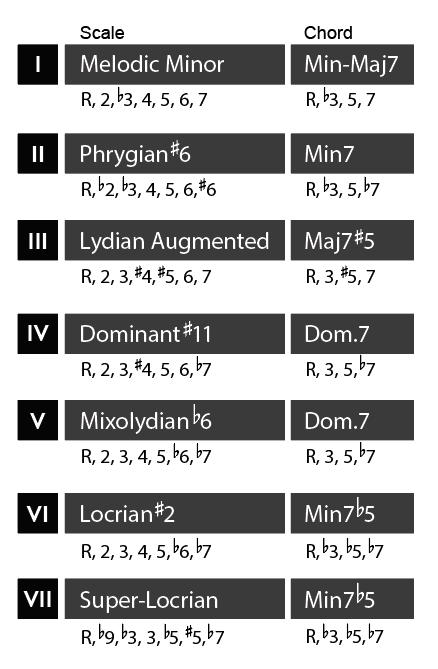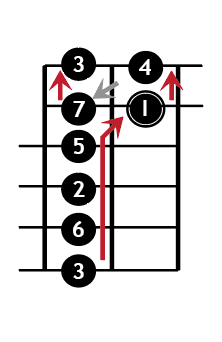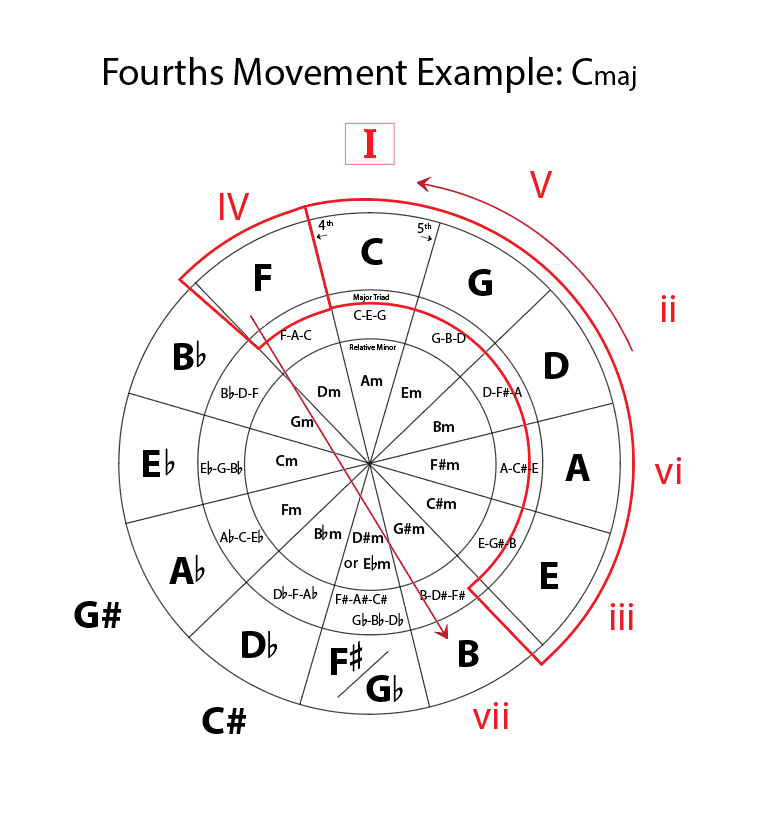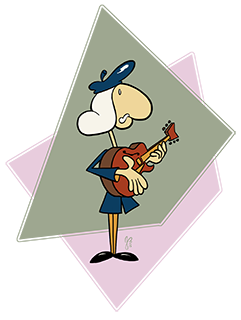1) They feature a strategy where you are only moving 1 finger on a grip.
2) They feature voice-leading -- the finger you move outlines a chromatic descent to the next chord
3) They expose how a small vocabulary of chord shapes can be re-used for different voicings
As I've mentioned before, the first teacher who attempted to teach me about jazz guitar recommended the Mickey Baker books. While they were nice at getting some basic and hip sounds going, there were a lot of holes to be filled. While I don't particularly recommend starting with them, the best thing about his books was he gives a relatively small number of chord shapes to learn and re-uses them to stand-in for different chords in a hip way. The first page of the PDF attempts to show how his chord shapes can be used in a ii-V progression.
The 1-finger ii-V is at the heart of what he initially presents, using a min6 as a Dom.9 voicing. Making a min7 chord (acting as the ii) into a min6 chord (by moving the chord's b7 down 1 fret) gives you a rootless Dominant 9 chord, which is used as the grip for the V chord in the sequence. Mr. Baker also shows that if you just hold or reposition min7 chord, you end up with a rootless Dom11 chord.
As you may know, the min6 chord not only sounds like a Dom.9 chord, it is also a half-diminished (min7b5) voicing. The second page of the PDF shows all the various ways the min6 and min7 chords can be interpreted. Understanding other uses for any grip you learn is a great thing to do.
Page 3 gives a few variations on a iii-VI-ii-V progression with Mickey's chord voicings. This is the next most essential progression to learn after the ii-V. Once you learn and hear the 2-5 and the 3-6-2-5, you will be able to abstract away several measures of many jazz standards which will make them easier to learn and remember. Instead of learning several measures of a standard, you can eventually just represent it in your mind and ear as a 3-6-2-5 leading to a tonic. If the six chord is a Dominant (has a major 3rd), then the 3-6 is like a ii-V going to the 2 of the ii-V which then goes to the tonic.
Mickey's variations include using a min7 shape moved down one fret to represent the tritone of the ensuing V chord. This tritone works out to be a Dom.7(#9) voicing. A more common written variation is to use a rootless Dominant #11 for a V, which also happens to be a Dom.7(#11) a tritone away. In addition to using a half-diminished (min7b5) shape as a rootless Dom.9 chord, we also see how a min7b5 shape can be grabbed as Dominant Altered chords. Finally, we see that the iii-7 chord can be a Maj9 voicing for the tonic.
Ideally you want to work out similar chord moves for every inversion of these chords. The remainder of the PDF will give you a start in that direction.
Page 4 begins the chord moves for a I-vi-ii-V in one position for all the basic inversions which are in the Jimmy Bruno Inversions dictionary (you should check that PDF out if you haven't already). This should allow you to do this chord move anywhere on the neck for any key. Remember that the vi-7 chord is homonymous with the Tonic as a Maj6. The squiggly arrow shows you will have to move up some frets to get the chord root on the correct note. The min6 of the ii is equivalent to the Dom.9 of the V chord (as well as the other homonyms shown on Page 2).
Page 9 shows a 3-6-2-5 progression with altered dominants as the 6 and the 5. The squiggly arrow is to alert that you will need to move the shape down on the neck to get the root in the right place. When the 6 and 5 of a 3-6-2-5 are dominants, the 'tonal center' is located a whole tone (2 frets) away from the final Tonic during the 3 to 6. The VI chord is a Dom.7(#11) while the V chord is a Dom.7(b9) -- which is also a Diminished voicing. Note that each of the Dominant voicings here are exactly the same chord if played a tritone away. Try out Mickey's other tritone subs -- making the tritone a min7 or min6 also gives a hip altered dominant sound to the V. You should also try grabbing a different ii-7 chord to serve as a Dom11 chord for the V.
The basic goal of practicing the content in this PDF is to increase your vocabulary of chord moves for basic building blocks of jazz harmony -- the 2-5, the 3-6-2-5 and the 1-6-2-5. With study, you will see these progressions again and again in jazz standards. The extended vocabulary will give you a host of options up and down the neck for playing over these progressions so you are not endlessly repeating yourself comping behind a soloist. Learning comping is more useful than just learning how to solo with scales or modes -- for starters, you will realistically be comping far more than soloing. But dig this -- when you start to picture the chord tones of these progressions all over the neck, they will also be the targets you can approach (scalewise, chromatically or any other way) in your solo to outline the harmony.
| mickey_baker_2-5.pdf |




 RSS Feed
RSS Feed
